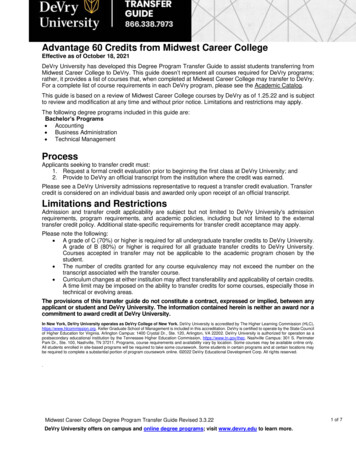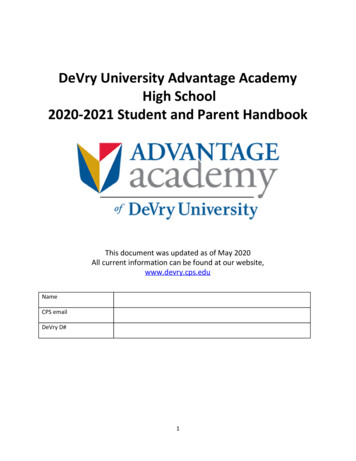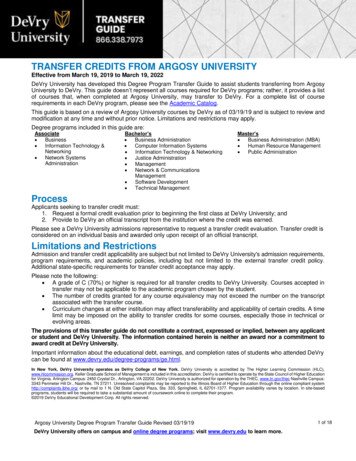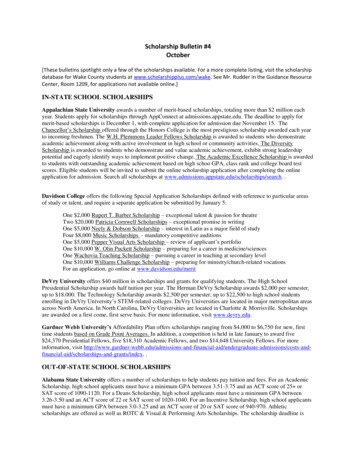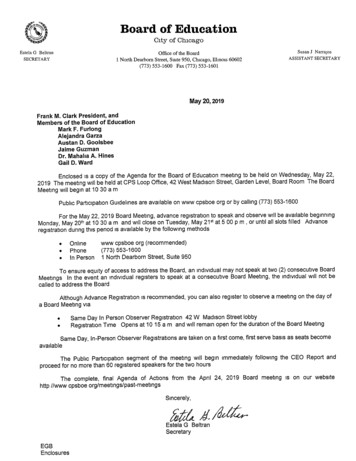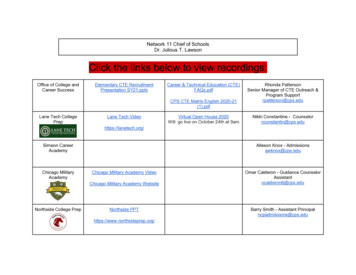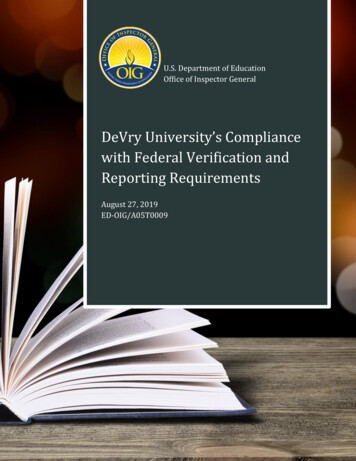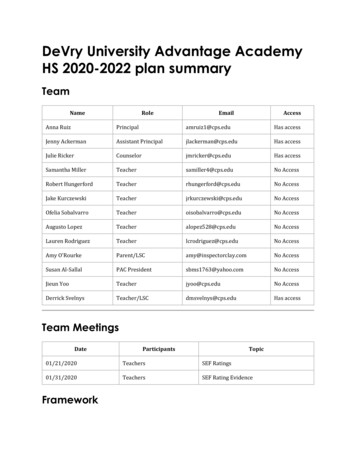
Transcription
DeVry University Advantage AcademyHS 2020-2022 plan summaryTeamNameRoleEmailAccessAnna RuizPrincipalamruiz1@cps.eduHas accessJenny AckermanAssistant Principaljlackerman@cps.eduHas accessJulie RickerCounselorjmricker@cps.eduHas accessSamantha MillerTeachersamiller4@cps.eduNo AccessRobert HungerfordTeacherrhungerford@cps.eduNo AccessJake KurczewskiTeacherjrkurczewski@cps.eduNo AccessOfelia SobalvarroTeacheroisobalvarro@cps.eduNo AccessAugusto LopezTeacheralopez528@cps.eduNo AccessLauren RodriguezTeacherlcrodriguez@cps.eduNo AccessAmy O'RourkeParent/LSCamy@inspectorclay.comNo AccessSusan Al-SallalPAC Presidentsbms1763@yahoo.comNo AccessJieun YooTeacherjyoo@cps.eduNo AccessDerrick SvelnysTeacher/LSCdmsvelnys@cps.eduHas accessTeam MeetingsDateParticipantsTopic01/21/2020TeachersSEF Ratings01/31/2020TeachersSEF Rating EvidenceFramework
Category scoring 1 NONE or FEW of the practices are CONSISTENTLY evident.2 FEW of the practices are CONSISTENTLY evident for FEW students and/or staff.3 MOST of the practices are CONSISTENTLY evident for SOME students and/or staff.4 Nearly ALL practices are CONSISTENTLY evident for ALL students and/or staff.Subcategory scoring 1 Practice is not consistently evident for ANY students and/or staff.2 Practice is CONSISTENTLY evident for FEW students and/or staff.3 Practice is CONSISTENTLY evident for SOME students and/or staff.4 Practice is CONSISTENTLY evident for ALL students and/or staff.Not scoredLeadership and Structure for Continuous Improvement 3 - Leadership for Continuous Improvemento 3 Set the direction and create a sense of purpose by building consensus on andimplementing a shared visiono 3 Inspire a culture of collective responsibility for ALL students to succeed and forbuilding a safer and more supportive environment throughout the school, not justin their own classrooms (REQUIRED: OSEL)o 3 Empower others to make or influence significant decisions (REQUIRED: OSEL)o 4 Enable staff to focus and prioritize what matters mosto 4 Employ the skills to effectively manage changeo 4 Make ?safe practice? an integral part of professional learningo 4 Collaborate, value transparency, and inform and engage stakeholderso Evidence: "Students don't fully understand the value of their participation in thisprogram We do not have transparency between college and HS grade books,and no facilitation of communication across HS and college staff Informationalmeetings BOY with parents and students, State of the School presentation, SATgoal setting presentation/excercise helped communicate mission and visionStudent Voice committee is coming together, but it's not representative of ourdemographics Teacher-led PD meetings show shared leadership No specific,consistent methods, channels for problem solving. Need to move beyond talkingabout the problems and defifning a process for problem resolution Celebrationboard and announcements are used to acknowledge positive contributionsTeacher Bulletin is a good improvement that we didn't have before Handling thenew building updates and informing staff on regular basis helps shield from theuncertainty and ""in the weeds"" details All teachers have high standardss andexpectations for students (see skills-baseed ladders, curriculum maps in Atlas) Allstaff signed the CPS-aligned handbook There is no clear path or communicationto challenge staff to grow. Not a whole lot of mentoring happening. Student workprotocol is helping with sharing knowledge, review new strategies, and discussimplementation challenges Academic support list only shows HS classesAcademic support is effective because the list decreases Grade-level teamsmeet weekly, but only address advisory goals Some teachers drive theconversation, not all voices are equitably heard. Need diverse channels forgathering teacher input. School-wide meetings are informational and focus ondistrict priorities. Need other avenues to meet and discuss internal issues that
affect the whole school. Suggest Friday meeting? Need a better process forsoliciting teacher input and building consensus around school-wide initiatives,policies, and procedures before implementing/communicating to students."Student work protocol PD, gradebook PD, MSMV, CIW review, Erie Healthpartnership, DeVry University partnership, learning walk (local and network),aggregated data analysis, Academic Approach data analysis and SAT Tutoring,collaborative math team interview, teacher representation at ALSC and PPC3 - Structure for Continuous Improvemento 3 Engage in ongoing inquiry (e.g. continuous improvement cycles) as a basis forimprovemento 3 Build the capacity of teacher teams to lead cycles of learning and problemsolving focused on student learning data and student worko 3 Design professional learning (PL) to achieve school-wide improvement goalso 4 Design and implement school day schedules that are responsive to studentneedso 4 Align the budget to the CIWP priorities and the mission of the schoolo 3 Strategically hire, assign, and retain teachers to create balancedgrade/content teams with a variety of strengths to ensure all students haveequitable access to high-quality teacherso 3 The local school council (LSC) or another community oversight committee ofboard is actively and productively involved in supporting SEL initiatives andimprovements to school climate (REQUIRED: OSEL)o 3 Physical surroundings convey a positive, student-centered school environment(REQUIRED: OSEL)o Evidence: "Need a cycle for continuous improvement cycle Difficulty filling andretaining math position Equity of opportunities not evident. Need a better way tocommunicate available opportunities for leadership and a fair process forassigning to a role" New business track for university coursework, reinstate first 20days, ELL PDs, student work protocol, MTSS, DUAA Communication Hub, learningwalks (local and network), differentiation, school-wide classroom supports,teacher-led PDs, best practices implementationDepth and Breadth of Student Learning and Quality Teaching 3 - Curriculumo 3 Provide culturally relevant/sustaining curriculum that provides opportunities toexplore and celebrate student's communities, culture, history, and languageo 4 Utilize the ?big ideas? that should be taught to determine whether students arebeing taught the body of knowledge, the understandings, and the skills expectedo 3 Curriculum connects to real world, authentic application of learningo 3 Curriculum is aligned to expectations of the standardso 4 Integrate the teaching of academics and the ISBE Social Emotional LearningStandards (REQUIRED: OSEL)o 4 Expand access to diverse, contemporary well-stocked text collections thatprovide opportunities for all students to engage with text from a wide range ofgenres, including text of appropriate grade level complexityo Evidence: "Category: Transitions, College&Career Access, & Persistence Hispanic College Tour, Naviance Scholarship Portal,First GenerationScholarship,Identity Issues, Naiviance Career Research, Junior Parent Night,College Match or Fit, Award Letter Workshop, Junior and Senior Advisory Topics,Student Contracts. Category: MTSS- Monday student attendance tracker,Student Contracts,Academic Support List. Category:Balanced Assessment and
Grading- Student Work Protocol, Schoolwide Censius for grading, ClassroomProtocol, PD on Assessment and Peer on Peer Reflection. Category: CurriculumTedTalks, Utilize teachers (Examaple:Ofelia or Derrick) to present real world lessonsand learning or applications, Spreadsheets of getting to know students.Instructions for all categories Notes 1. MTSS: All teachers provide tutoring, MTSSSpreadsheet of behavior and attendance tracked regularly, Peer Tutor Budget,PD on SEL Strategies. Robert, Maria Bridgette great at MTSS meetings 2.BalancedAssessment and Grading: Advisory, PD on student engagement question andinstruction techniques, Learning more about scaffolding cohesiveness amongststudent groups, Foster relationships amongst students, Student icebreakers, BoldGirls. 3.Curriculum: Department give past data to build on for a new yearstudents, Training or support for ATLAS standard curriculum, Offer the same thingwe have for Math Tutoring like a English 101 etc. Peer Tutoring, Student TeacherDay3 - Instructiono 4 Create a culture that reflects high expectations for all students and enablespractice and perseverance for each individual student (REQUIRED: OSEL)o 3 Engage students in learning and foster student ownershipo 3 Use questioning and discussion as techniques to deepen student understandingo 4 Plan and assign tasks that are cognitively challenging for individual studentsand require students to provide evidence of their reasoningo 3 Provide students frequent, informative feedbacko 3 Persist in adjusting instruction so individual student misunderstandings oradvanced needs are successfully accommodatedo 4 Engage all learners in content areas by differentiating and fully integratingopportunities for all learnerso 4 Tasks convey the key shifts and practices of the discipline. (See departmentalguidance for Arts Education, Health and Physical Education, Literacy, Math,Science, Social Science & Civic Engagement)o Evidence:3 - Balanced Assessment and Gradingo 3 School-based teams discuss and monitor the effect of teaching on studentlearning, integrate formative assessment into instruction and intervention ofindividual studentso 4 Use multiple measures (i.e. a range of assessment types and at multiple points intime) to supplement district-centralized assessments with other formativeassessments to provide a more comprehensive picture of student learningo 3 ILT, GLT, and interventionists use a Problem Solving Process approach toscreening, diagnostic, and progress monitoring assessments to identify specificgaps and monitoring improvement for students within all tierso 3 Make assessments accessible to students, including diverse learners and EnglishLearners through employing features of universal design and use ofaccommodations and, where needed, modificationso 3 Utilize assessments that reflect the key shifts in content areas in teacher createdor selected assessmentso 3 Utilize assessments that measure the development of academic language forEnglish learnerso 4 Have access to and analyze school-wide, teacher team, and classroomassessment data to determine instructional effectiveness, in house criteria, andsubsequent learning needso 3 Improve and promote assessment literacy
3 Have a grading system that clearly, accurately, consistently, and fairlycommunicates learning progress and achievement to students, families,postsecondary institutions, and prospective employerso Evidence:3 - MTSSo 4 ON TRACK - Provide universal supports to prevent failing and absenteeism andtargeted interventions for grades below ?C? or chronic absenteeism (REQUIRED:MTSS)o 4 MTSS Team completes SEF ratings for MTSS subcategories (denoted as"REQUIRED MTSS") at MOY and EOY to reflect on MTSS fidelity of implementation(REQUIRED: MTSS)o 4 MTSS Team uses MTSS Framework Implementation Guide or other resources fromCentral Office to align priorities to outcomes (REQUIRED: MTSS)o 3 Administration supports MTSS Team with resources needed to make changes toframework/system (REQUIRED: MTSS)o 4 School tracks growth of ALL students, specifically students receiving Tier 2 andTier 3 supports based on district-wide available data to accurately assess studentachievement results and school practices (REQUIRED: MTSS & OSEL)o 4 Shared Leadership: Administration recruits a diverse MTSS core team (contentareas, counselors, etc.),or identifies an existing team that is responsible for drivingthe school?s MTSS Framework and Implementation (REQUIRED: MTSS & OSEL)o 4 Shared Leadership: MTSS Team uses multiple data sources to determine localTiering Criteria For Tier 1, Tier 2, Tier 3 interventions (REQUIRED: MTSS & OSEL)o 4 Shared Leadership: MTSS Team develops a Menu of Interventions that clearlyoutlines the supports, resources, system and structures for Tier 1, Tier 2, and Tier 3(REQUIRED: MTSS & OSEL)o 3 Shared Leadership: School Teams communicate MTSS related outcomes to allstakeholders (REQUIRED: MTSS & OSEL)o 3 Problem Solving Process: MTSS Team, teachers, and intervention providers usethe Problem Solving Process (PSP) to identify root causes and contributing factorsof deficit areas (REQUIRED: MTSS & OSEL)o 4 Problem Solving Process: MTSS Team gathers and utilizes multiple data sourcesto define the problems and take action for Tiers 1, 2, and 3 (REQUIRED: MTSS &OSEL)o 3 Curriculum and Instruction: Instructional staff provides culturally relevant, highquality, standards-aligned curriculum in which SEL instruction is embedded intocore content (REQUIRED: MTSS & OSEL)o 3 Curriculum and Instruction: Instructional staff provides differentiated instructionto meet the needs of all students (REQUIRED: MTSS)o 3 Curriculum and Instruction: Instructional staff provides interventions that areresearch-based (REQUIRED: MTSS & OSEL)o 3 Curriculum and Instruction: School Teams analyze data to prioritize opportunitiesto improve instruction, guide grouping, re-teaching and to identify/prioritizeinstructional needs (REQUIRED: MTSS)o 3 Progress Monitoring (PM): School identifies and uses a research-baseddiagnostic tool and process to determine root-cause and area of need for Tier 2and Tier 3 supports (REQUIRED: MTSS & OSEL)o 3 Progress Monitoring (PM): School Teams progress monitor and analyze studentresponse to intervention throughout the intervention cycle to determine andimplement needed adjustments (REQUIRED: MTSS & OSEL)o 3 Progress Monitoring (PM): MTSS Team clearly defines the method, duration,frequency, and measures for progress monitoring (REQUIRED: MTSS & OSEL)o
3 Family & Community Engagement: School establishes regular communicationwith families to build their understanding of MTSS, purpose of interventions andtiered support systems, and how it will support their child (REQUIRED: MTSS & OSEL)o 4 Family & Community Engagement: School teams develop a process ofcommunication for formally notifying parents/families when their child is selectedto receive Tier 2 or Tier 3 interventions (REQUIRED: MTSS & OSEL)o 3 Family & Community Engagement: Administration and school teams establishand continually evaluate community partnerships to support MTSSimplementation (i.e. providing Tier 2 or Tier 3 supports) (REQUIRED: MTSS & OSEL)o 4 Family & Community Engagement: School teams ensure that feedback/inputfrom families is taken into consideration during the PSP and intervention planning(REQUIRED: MTSS & OSEL)o 4 Family & Community Engagement: School engages families in supporting withprogress monitoring of their students (REQUIRED: MTSS & OSEL)o 3 Fidelity of Implementation: School teams utilize the SAM at BOY, MOY and EOYto reflect on MTSS fidelity of Implementation (REQUIRED: MTSS)o 3 Fidelity of Implementation: School teams use MTSS Framework ImplementationGuide and/or other resources from Central Office to align priorities to outcomes(REQUIRED: MTSS)o 3 Fidelity of Implementation: School teams leverage other self-reflectingprocesses such as the SEF or the CIWP to evaluate and improve MTSS frameworkand implementation (REQUIRED: MTSS)o 4 Fidelity of Implementation: Administration supports the fidelity of MTSS practices,principles, and resources needed to make suitable changes to systems andstructures (REQUIRED: MTSS)o Evidence:4 - Transitions, College & Career Access, & Persistenceo 4 TRANSITIONS - Have structures and processes in place to ensure successfultransitions (e.g. into school, grade to grade, school to school, school to postsecondary)o 4 AWARENESS - Expose students early to academic/professional worlds beyond K12o 4 READINESS ? Ensure equitable access to college preparatory curriculumo 4 SUCCESS - Provide direct assistance to all students and families through everystage of the college selection, application, and entry process (Transition toCollege (HS)) including, but not limited to academic planning/advising to assistwitho Evidence:o Quality and Character of School Life 3 - Relational Trusto 4 Foster respectful and supportive student-student interactions, with strong normsfor responsible behavior, to encourage a sense of belonging to the school andthe classroom community (REQUIRED: OSEL)o 4 Foster supportive, caring and respectful staff-student interactions, so that eachstudent has at least one trusted adult in the school (REQUIRED: OSEL)o 3 Adults support and respect one another, personally and professionally(Teacher-Teacher Trust, Teacher-Principal Trust) (REQUIRED: OSEL)o Evidence:3 - Student Voice, Engagement, and Civic Lifeo 3 Study politics
3 Become informed voters and participants in the electoral process3 Engage in discussions about current and controversial issues3 Explore their identities and beliefs (REQUIRED: OSEL)3 Exercise student voice (REQUIRED: OSEL)3 Authentically interact with community and civic leaders2 Engage with their community2 Take informed action where they work together to propose and advocate forsolutionso 2 Experience a schoolwide civics cultureo Evidence: APUSH, DeVry Ethics and Political Science courses, Voter registrationdrive, Constitution tutoring, AP Lang and Comp curriculum, Humanities andTheater electives for diverse and critical analysis, Student Voice Committee,student contests (hoodie design), special advisory on N-word (studentrequested), special advisory for seniors on transition to new space and transitionto new staff, advisory curriculum, Gay Straight Alliance new for SY19-20, CPSTransgender PD, CPS Title IX PD, Disaggregated Data Grouping by Gender (SATAnalysis), service learning project embedded in college Ethics course, AlumniPanel, MVMS student survey, Erie Health partnership4 - Physical and Emotional Safetyo 4 Ensure students and adults feel physically, socially, intellectually, andemotionally safe throughout the school (REQUIRED: OSEL)o 4 Provide clear procedures for reporting and responding to concerns aboutsafety and well-being (REQUIRED: OSEL)o 4 Manage efficient and orderly transitions between activities (REQUIRED: OSEL)o 3 A representative team (e.g. admins, teachers, staff, families, & students)dedicated to school climate development meets regularly to make decisionsthat promote SEL and create supportive, restorative, and trauma sensitiveenvironments (REQUIRED: OSEL)o Evidence:3 - Supportive and Equitable Approaches to Disciplineo 3 INSTRUCTIVE - Integrate universal SEL skills instruction in disciplinary responses(REQUIRED: OSEL)o 3 RESTORATIVE - Employ a discipline system that guides students to takeownership, resolve conflict, and learn from their actions (REQUIRED: OSEL)o 4 SUPPORTIVE - Employ a discipline system that assesses the root causes of studentbehaviors and utilizes a trauma-informed, multi-tiered approach to supportivesocial and emotional intervention (REQUIRED: OSEL)o 4 EQUITABLE - Employ a discipline system that ensures equity across groups ofstudents, school-wide and district-wide (REQUIRED: OSEL)o Evidence: Counseling support groups, restorative justice conversations (Jenny),MTSS, Academic Support, MSMV, Dean of School Climate (Jenny) new for SY1920, DUAA Communication Hub new for SY19-20, school-wide Tier 1 classroomsupports3 - Family & Community Engagemento 4 Establish a welcoming environment for families and community members that iswarm, inviting, and helpful (REQUIRED: OSEL)o 2 Provide frequent, high quality, well publicized opportunities for families andcommunity to participate in authentic and engaging activities in the schoolcommunity (e.g. student performances/ exhibitions, literacy, or math events).o 3 Provide multiple opportunities for parents to ask questions, raise concerns, andgive feedbackooooooo
oooooo3 Teachers and families see each other as partners in educating children, and allfamilies are directly invited to formally contribute and participate in decisionmaking about their children and about the school (REQUIRED: OSEL)4 Communicate with families proactively and frequently about class andindividual activities and individual student?s progress (REQUIRED: OSEL)3 Conduct intensive outreach to families in need of specialized support throughhome visits and collaboration with social service agencies (REQUIRED: OSEL)3 Partner equitably with parents speaking languages other than English3 Partner with one or more organizations that share the values of the school andhave a complementary mission to the school?s vision (REQUIRED: OSEL)Evidence: Parent Advisory Council, Advisory Local School Council, Parent andStudent Orientations, ISAC/Ladder Up presentations, Report Card Pick Up, ParentConferences, Academic Support, Principal Bulletin, Parent Portal, Senior ParentNight (college counseling), Junior Parent Night (college counseling), FAFSAworkshops, senior/junior contracts, DUAA Participation Agreement, AcademicApproach, four bilingual speaking staff, Jenny's outreach to students with poorattendance, STLS program, referral to Department of Human Services (DHS), GradNight at Six Flags, Prom, Spirit Cruise for Senior Luncheon, athletic partnership withAlcottSchool Excellence Framework PrioritiesScoreArea offocusFramework dimension and category3Depth and Breadth of Student Learning and Quality Teaching: Balanced Assessmentand Grading03Depth and Breadth of Student Learning and Quality Teaching: Curriculum13Depth and Breadth of Student Learning and Quality Teaching: Instruction23Depth and Breadth of Student Learning and Quality Teaching: MTSS53Leadership and Structure for Continuous Improvement: Leadership for ContinuousImprovement03Leadership and Structure for Continuous Improvement: Structure for ContinuousImprovement03Quality and Character of School Life: Family & Community Engagement43Quality and Character of School Life: Relational Trust03Quality and Character of School Life: Student Voice, Engagement, and Civic Life33Quality and Character of School Life: Supportive and Equitable Approaches toDiscipline0
ScoreArea offocusFramework dimension and category4Depth and Breadth of Student Learning and Quality Teaching: Transitions, College& Career Access, & Persistence04Quality and Character of School Life: Physical and Emotional Safety0GoalsAreas of critical need and root cause analysis[X] By checking this box, I confirm that we have recalled previous data analysis, conducted newdata analysis as needed, and indicated 3-5 areas of critical need in our school's CIWP Googlesheet for the Area of Critical Need component. We will now move on to the Goals component.;[X] By checking this box, I confirm that we have completed a root cause analysis for each areaof critical need and indicated 3-5 root causes in our school's CIWP Google sheet for the RootCause Analysis component.Area of Critical Need 1Root Cause 1Growth-EBRW 11th gradeLack of focus on academic discourse, wordsin context across disciplines, and readingstrategies in all classes.Attainment-Percent of Student MeetingCollege Readiness BenchmarksLack of rigor across content areas to ensureattainment.College Persistence RateStudents graduating not meeting one or bothcollege readiness benchmarks and beingunderprepared for college rigor. Additionally,lacking self-advocacy and soft-skills requiredto persist.Area of Critical Need 2Root Cause 2Area of Critical Need 3Root Cause 3Vision metricsMetrics (select 3–5)Studentgroups (1–2for eachmetric)SY19 dataactual(provided byCPS)2020–2021goal2021–2022goalSQRP: SAT Annual Growth PercentileReadingOverall72.0075.00This metric was chosen because of the slowgrowth we have experienced over the lastFemale60.0065.00
Metrics (select 3–5)Studentgroups (1–2for eachmetric)SY19 dataactual(provided byCPS)2020–2021goal2021–2022goalfew years and the direct connection tostudent success in college.Vision: College Readiness SATOverall75.0078.00This metric was selected because ourcollege readiness has been inconsistent andwill ensure better persistence.Female68.0073.00SQRP: College Persistence RateOverall80.0083.00Overall94.0095.00This metric was chosen based on ourstagnant persistence rate over the last 5years.Vision: Attendance RateThis metric was selected because of itsimpact on our SQRP and its its impact onreadiness and growth.(Blank)Required metrics (Highschool) (133% complete)2018-2019ActualMy Voice, My School 5Essentials SurveyCompletion 2022Goal99.0099.0099.00Custom metrics (0% complete)2018-2019 ActualStrategiesStrategy 12019-2020 Actual2019-2020 Goal2020-2021 Goal2021-2022 Goal
If we do.create more opportunities for parents, community members, and alumni to share theirfield of study, expertise, and experiencesThen we see.students exposed to different career paths, majors, and job opportunitieswhich leadsto.increased college and career fit, enrollment and persistence.BudgetDescriptionTags (Not started) Create parent survey with options on how parents would like toengage with DUAA.Tags: (Not started) At orientation, invite both junior and senior parents to sign up toshare their field of study, education, and career with students. Maintain contactwith parents and help them prepare their presentations to students.Tags:Action steps (Not started) Get 2-3 parents to host a field trip at their workplace. Surveyparents at orientation to get volunteer pool, then follow up to ensure workplaceis actually available and willing. Continue to follow up for scheduling andexecution.Tags: (Not started) Create a parent committee to shepherd and drive these activities.Tags:Strategy 2If we do.maintain our systems of monitoring and intervening while adding school-wideprofessional development on Tier 1 classroom practice and differentiationThen wesee.more effective differentiation and classroom based interventionswhich leadsto.fewer students on Academic Support, higher GPAs, increased college readiness, and betterpersistence rates.BudgetDescription
Tags (Not started) Create Professional Development to support first 20 day strategiesto establish and maintain SEL, community norms, and school culture whileengaging tier 1 interventions for student success.Tags: (Not started) Create and present MTSS Tier 1 Student Support Tracker. Utilizetracker in MTSS meetings to make data driven decisions for student support.Tags:Action steps (Not started) Create and present PD focused on distinguishing differentiation ofcurriculum and instruction. Establish standards and norms for implementingaccommodations, modifications and strategies for increasing student academicachievement and functional participation in the classroom.Tags: (Not started) Utilize Aspen to track and monitor MTSS studentsupport/intervention data. Reflect on data collected on MTSS tracker to makeinformed decisions on student needs and supports. (Attend Aspen MTSS trackertrainings)Tags:Strategy 3If we do.use PD to ensure rubrics for formative and summative assessments are aligned tostandards and mastery targetsThen we see.curriculum and instruction aligned to students' need based on that progress monitoringwhich leadsto.increases in EBRW growth, college readiness and persistence.BudgetDescriptionTags Action steps(Not started) Review of Curriculum Maps to ensure alignment betweencurriculum, instruction, and assessments to standards particularly focusing onpower standards for SAT.Tags:
(Not started) Create common language around verbs in standards to be usedacross all courses using College Board definitions as a starting point ensuring APcourses are accurately represented.Tags: (Not started) Continual use of ATLAS Looking at Student Work protocol duringembedded PD sessions allowing for collaboration around assessments.Tags: (Not started) Create Departmental Rubrics and use a learning cycle to test themout and make adjustments.Tags: (Not started) Create rubrics for ELA standards that can be used across contentareas.Tags:Strategy 4If we do.provide opportunities to explore current issues in our community through culturallyrelevant text across content areasThen we see.students engaging in reading and discussing rigorous text with complex vocabulary andconceptswhich leadsto.increases in: EBRW scores, students meeting college readiness benchmarks, collegeenrollment, and persistence.BudgetDescriptionTags (Not started) Revise and supplement current curriculum with complex texts thatreflect current social debates and controversies.Tags:Action steps (Not started) Incorporate readings from NewsELA that enhance the unit's focus.Teachers will explore NewsELA features such as word in context (Power Words),reading quizzes, and writing feature.Tags:
(Not started) Develop common interdisciplinary literacy strategies/terminologythat students can recognize and utilize across courses/classes (i.e. ?First TwentyDay?s? Strategies?)Tags: (Not started) Review text complexity of current content using Text-ComplexityRubric.Tags: (Not started) Continue incorporating Academic Approach strategies, practicetests, and SAT Prep classesTags:Action PlanStrategy 1Create parent survey with options on how parents would like to engage with DUAA.Jul 01, 2020 to Sep 30, 2020 - AdminAt orientation, invite both junior and senior parents to sign up to share their field of study,education, and career with students. Maintain contact with parents and help them preparetheir presentations to students.Jul 01, 2020 to Aug 31, 2020 - Julie and JennyGet 2-3 parents to host a field trip at their workplace. Survey parents at orientation to getvolunteer pool, then follow up to ensure workplace is actually available and willing. Continue tofollow up for scheduling and execution.Sep 01, 2020 to Jun 18, 2021 - JennyCreate a parent committee to shepherd and drive these activities.Apr 01, 2021 to Sep 01, 2021 - Jenny, Jessie, JulieStrategy 2Create Professional Development to support first 20 day strategies to establish and mainta
DeVry University Advantage Academy HS 2020-2022 plan summary Team Name Role Email Access Anna Ruiz Principal amruiz1@cps.edu Has access Jenny Ackerman Assistant Principal jlackerman@cps.edu Has access . DeVry University partnership, learning walk (local and network), aggregated data analysis, Academic Approach data analysis and SAT Tutoring,
